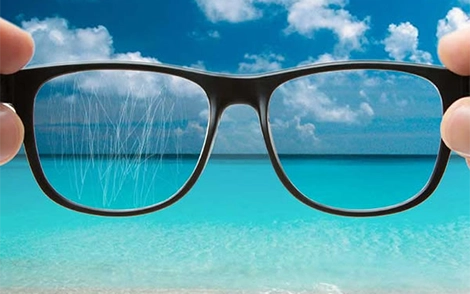If you’ve ever owned eyeglasses, you know all too well the nightmare of scratches. Tiny marks on your lenses can also warp your vision and create glare. And, of course, the life of your glasses is shortened. Which is why so many eyewear brands tout “scratch-resistant lenses” — but how much of that is legitimate protection and how much is simply marketing hype?
We at Smart Opticals believe the best way to assist our customers is to educate them. Here’s what you need to know about scratch-resistant lenses — and what does and doesn’t work.
What Does “Scratch-Resistant” Really Mean?

Let’s begin with a popular misconception: scratch-resistant does not mean scratch-proof.
There is no such thing as a lens that never gets damaged. But lenses described as scratch-resistant actually have a built-in hard coating, making them far more durable than uncoated lenses.
This coating helps protect against:
- Minor scuffs from rough cleaning material
- Accidental bumps or drops
- Regular handling and storage wear
So while you shouldn’t expect your lenses to emerge scratch-free from getting dropped on gravel, you can expect them to remain clearer and last longer, with proper care.
What Really Works: Proven Scratch-Resistant Technologies
Lenses have come a long way since then. The highest-quality scratch-resistant lenses are made when the hard coat is chemically bonded to the lens during a coating process.
Here are the coatings that actually work:
Hard Coat (Base Scratch-Resistant Layer)
This is the first line of defence — a thin, clear coat that’s applied during manufacturing to make the surface more difficult to scratch.
- Found on polycarb, Trivex, and high-index lenses
- Typically, a feature found on higher-quality lenses
Hard Multicoat with Anti-Reflective (AR) Coating
- Most performance ARs have a scratch-resistant layer already built in. This configuration increases durability and minimizes glare, improving the sight picture.
Coatings for Ultraviolet and Blue Light Protection
- Though their purpose is to filter light, coatings are often applied with hard coats for a second level of protection and longer lens life.
At Smart Opticals, our lenses are coated with multi-layer coatings that enhance the overall viewing experience and provide 5 times more “scratch-resistant” chemistry.
What’s Just Marketing Hype
Unfortunately, not all “scratch-resistant” claims are created equal. Cheap glasses have cheap surface sprays or thin coatings that generally last three to six months.
Be cautious if you notice:
- Easily scratching lenses when they were “resistant”
- Coating peeling or flaking
- Fogging or streaking when cleaning
These are marks of subpar coatings or inferior manufacturing — common in cheap lenses and mass-market eyewear.
Tip: Make sure to ask if the lenses are factory-coated or treated after manufacturing. Factory coatings are much harder and longer-lived.
How to Keep Your Lenses Scratch-Free
Care for even the hardest coatings. Adopt these easy routines to prolong lens life:
- Avoid using optics cleaning cloths or lens cleaner.
- Do not wipe the eyes with tissues, paper towels, or clothing.
- Keep your glasses in a hard case when not wearing them
- Never rest your lenses on the back of surfaces
- Wash dust before wiping for no micro-scratches
There, a little care can go a long way — especially in combination with good lens coatings.
Final Thoughts
Scratch-resistant lenses aren’t a myth — but they’re not made from magic, either. Proper protection is found in good coatings, cautious usage and reputable optical knowledge.
So the next time you get fitted for new glasses, skip the buzzwords and ask what lies beneath the coating. With Smart Opticals, you can rest assured that you’ll get lenses that perform as well as they look.
